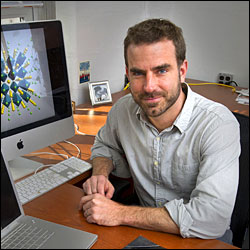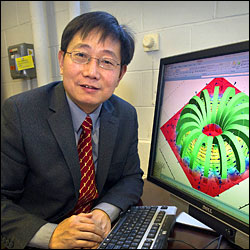Meet Jason Graetz and Qiang Li
Of the Ten BNL Scientists Granted Tenure
February 6, 2012
Brookhaven Science Associates (BSA) granted tenure to 10 BNL scientists, effective December 1, 2011. The scientists are James Alessi, Collider-Accelerator Department; Hooman Davoudiasl, Physics Department; Jason Graetz, Sustainable Energy Technologies Department; Ralph James, Nonproliferation and National Security Department; Qiang Li, Condensed Matter Physics and Material Sciences Department; Chang-Jun Liu, Biology Department; Ping Liu, Chemistry Department; Allen Orville, Biology Department; Paul Sorensen, Physics Department; and Bo Yu, Instrumentation Division.
Tenure appointments are made after a rigorous selection procedure culminating in a comprehensive review of each tenure case by the Brookhaven Council, an elected body that advises the Director on matters of concern to the scientific staff. The BSA Science & Technology Steering Committee oversees the tenure process and makes final recommendations to the BSA board. The newly tenured scientists are featured in alphabetical order, or as photographs or articles become available. James Alessi and Hooman Davoudiasl were featured on January 26, and Ralph James and Ping Liu, on January 27. The contributions of Jason Graetz and Qiang Li are summarized below.
Jason Graetz, Sustainable Energy Technologies Department
By Joe Gettler

Jason Graetz
Materials Scientist Jason Graetz was granted tenure for his internationally recognized studies on metal hydrides — materials used for hydrogen storage in fuel cell vehicles.
Heading the Energy Storage Group in the Sustainable Energy Technologies Department (SET), Graetz focuses his research on materials for energy storage. Graetz systematically explored the properties of aluminum-based hydrides and demonstrated that they can meet strict requirements for energy storage in future fuel cell-powered vehicles. These compounds now attract much attention for their potential as hydrogen storage media for fuel cell applications.
“Jason’s pioneering studies of these compounds have opened a new avenue in this field and established aluminum hydride as one of the few promising materials for practical hydrogen storage — a real scientific achievement,” said Pat Looney, SET chair. “His accomplishments have contributed significantly to the Laboratory’s mission.”
Graetz’s research is important for BNL’s major scientific initiative of energy security, which includes reducing the carbon footprint from energy use by developing sustainable chemical conversions to generate renewable fuels.
More recently, Graetz has started researching high-capacity electrodes for lithium ion batteries. This has led to strong ties with leading researchers in the field. He participated in the Northeast Chemical Energy Storage Center Energy Frontier Research Center at Stony Brook University, and has gained national recognition.
Graetz earned a Ph.D. in materials science at the California Institute of Technology in 2003 and joined BNL in 2004. In 2008, he won the Presidential Early Career Award for Scientists and Engineers for contributions towards achieving national energy independence through the development of hydrogen storage compounds. His publications include an invited review for Chemical Society Reviews in 2009 that became the most referenced review article in that field, and he holds three patents.
Qiang Li, Condensed Matter Physics & Materials Science Department
By Natalie Crnosija

Qiang Li
Scientist Qiang Li of the Condensed Matter Physics & Materials Science (CMPMS) Department was awarded tenure for his outstanding research in basic and applied superconductivity. A leader in the applied superconductivity field, Li has conducted research ranging from basic physics and material science studies to the applications of high temperature superconductors, which has greatly impacted today’s high temperature superconductor technology.
Li now leads the Advanced Energy Materials Group, which studies superconducting and thermoelectric materials. He has more than 120 peer-reviewed publications, including one Nature, two Science, and ten Physical Review Letters papers, and currently has four patents, provisional or pending. Among Li’s fundamental research achievements, his work provided important insights into the two dimensional fluctuation superconductivity and relationship between grain boundaries, and the transport properties of high temperature superconductors.
Qiang Li’s fundamental work has seen practical application in the superconducting wires now being developed for use in the electrical grid. More recently, he organized multi-institutional teams and developed two proposals for the Superconducting Magnet Energy Storage System for grid storage, and superconducting wires for direct drive wind generators in response to the DOE Office of Advanced Research Project Agency calls. Both received funding for the endeavors. If successful, these systems could significantly impact the future of renewable energy technology and will play a significant role in the BNL’s strategic energy research program.
“Qiang’s unique leadership talent and outstanding original research achievements in basic science as well as applied science and technology have made him an extremely valuable member of the department and BNL’s energy program,” said Peter Johnson, CMPMS Department chair.
Li joined BNL in 1991 with a Ph.D. in physics from Iowa State University.
2012-2831 | INT/EXT | Newsroom









